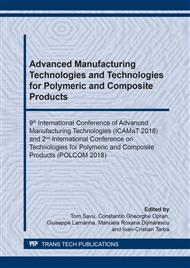[1]
M. Summers, Robot Capability Test and Development of Industrial Robot Positioning System for the Aerospace Industry, SAE International 114 (2005) 1108-1118.
DOI: 10.4271/2005-01-3336
Google Scholar
[2]
T. Brogardh, Present and future robot control development—An industrial perspective, Annual Reviews in Control 31 (2007) 69-79.
DOI: 10.1016/j.arcontrol.2007.01.002
Google Scholar
[3]
S. Hoshino, H.Seki, Y. Naka, Development of a Flexible and Agile Multi-robot Manufacturing System, 17th IFAC World Congress (2008) 15786-15791.
DOI: 10.3182/20080706-5-kr-1001.02669
Google Scholar
[4]
A M. Goodrich e A. Schultz, Human robot interaction: a Survey, Found Trends HCI 1 (2007) 263-275.
Google Scholar
[5]
R. R. Murphy, R. Nomura, Billard A. e J. Burke, Human–Robot Interaction, IEEE Robotics & Automation Magazine 17 (2010) 85-89.
DOI: 10.1109/mra.2010.936953
Google Scholar
[6]
J. Schmidtler, V. Knott, C. Holzel e K. Bengler, Human Centered Assistance Applications for the working environment of the future, Occupational Ergonomics 12 (2015) 83-95.
DOI: 10.3233/oer-150226
Google Scholar
[7]
ISO/TS 15066, Robots and robotic devices: collaborative robots,, Technical Specification ISO/TS 15066, International Organization for Standardization, (2010).
DOI: 10.31030/2584636
Google Scholar
[8]
ISO 10218-1, Robots and robotic devices – safety requirements for industrial robots – Part 1: robots,, Norm ISO 10218-1, International Organization for Standardization, (2011).
DOI: 10.3403/30218711
Google Scholar
[9]
ISO 10218-2, Robots and robotic devices – safety requirements for industrial robots – Part 2: robot systems and integration,, Norm ISO 10218-2, International Organization for Standardization, (2011).
DOI: 10.3403/30187056
Google Scholar
[10]
A. De Luca, F. Caputo, A review on analytical failure criteria for composite materials, AIMS Materials Science 4 (2017) 1165-1185.
DOI: 10.3934/matersci.2017.5.1165
Google Scholar
[11]
R. Sepe, R. Citarella, A. De Luca, E. Armentani, Numerical and experimental investigation on the structural behaviour of a horizontal stabilizer under critical aerodynamic loading conditions, Advances in Materials Science and Engineering 2017 (2017).
DOI: 10.1155/2017/1092701
Google Scholar
[12]
F. Caputo, G. Lamanna, A. De Luca, V. Lopresto, Numerical simulation of LVI test onto composite plates, AIP Conference Proceedings 1599 (2014) 334-337.
DOI: 10.1063/1.4876846
Google Scholar
[13]
D. Perfetto, A. De Luca, G. Lamanna, A. Chiariello, F. Di Caprio, L. Di Palma, F. Caputo: submitted to Procedia Engineer (2018).
DOI: 10.1016/j.prostr.2018.11.079
Google Scholar
[14]
A. Califano, Modelling the Fatigue behavior of composites under Spectrum Loading, AIP Conf Proc 1981 (2018).
Google Scholar
[15]
F. Caputo, G. Lamanna, A. Soprano, Numerical modeling and simulation of a bolted hybrid joint, SDHM Structural Durability & Health Monitoring 7 (2011) 283-296.
Google Scholar
[16]
G. Lamanna, F. Caputo, A. Soprano, Handling of composite-metal interface in a hybrid mechanical coupling, AIP Conference Proceedings 1 (2012) 353-355.
DOI: 10.1063/1.4738494
Google Scholar
[17]
G. Lamanna, F. Caputo, A. Soprano, Geometrical parameters influencing a hybrid mechanical coupling, Key Engineering Materials 525-526 (2013) 161-164.
DOI: 10.4028/www.scientific.net/kem.525-526.161
Google Scholar
[18]
R. Sepe, G. Lamanna, A. Pozzi, Tensile Testing of Hybrid Composite Joints, Applied Mechanics and Materials 575 (2014) 452-456.
DOI: 10.4028/www.scientific.net/amm.575.452
Google Scholar
[19]
B. Furet, B. Jolivel, D. Le Borgne, Milling and drilling of composite materials for the aeronautics, JEC Composites 18 (2005) 41-44.
Google Scholar
[20]
R. Devlieg, T. Szallay, Applied Accurate Robotic Drilling for Aircraft Fuselage, SAE Int. J. of Aerospace 3 (2010) 180-186.
DOI: 10.4271/2010-01-1836
Google Scholar
[21]
F. Caputo, F. Di Gennaro, G. Lamanna, A. Lefons, A. Riccio, Numerical Procedures for Damage Mechanisms Analysis in CFRP Composites, Key Engineering Materials 569 (2013) 111-118.
DOI: 10.4028/www.scientific.net/kem.569-570.111
Google Scholar
[22]
F. Caputo, G. Lamanna, A. De Luca, R. Borrelli, S. Franchitti, Global–local FE simulation of a plate LVI test, SDHM Structural Durability & Health Monitoring 2 (2014) 1-15.
DOI: 10.32604/sdhm.2013.009.253
Google Scholar
[23]
F. Caputo, A. Greco, M. Fera, G. Caiazzo, S. Spada, Simulation Techniques for Ergonomic Performance Evaluation of Manual Workplaces During Preliminary Design Phase, Advances in Intelligent Systems and Computing 822 (2019) 170-180.
DOI: 10.1007/978-3-319-96077-7_18
Google Scholar
[24]
F. Caputo, A. Greco, E. D'Amato, I. Notaro, S. Spada, Human Posture Tracking System for Industrial Process Design and Assessment, Advances in Intelligent Systems and Computing 588 (2018) 3-15.
DOI: 10.1007/978-3-319-73888-8_70
Google Scholar
[25]
M. Fera, F. Fruggiero, A. Lambiase, R. Macchiaroli, V. Todisco, A modified genetic algorithm for time and cost optimization of an additive manufacturing single-machine scheduling, IJIEC International Journal of Industrial Engineering Computation 9 (2018) 423-438.
DOI: 10.5267/j.ijiec.2018.1.001
Google Scholar
[26]
B. Yuce, F. Fruggiero, M.S. Packianather, D.T. Pham, E. Mastrocinque, A. Lambiase, M. Fera, Hybrid Genetic Bees Algorithm applied to single machine scheduling with earliness and tardiness penalties, Computers & Industrial Engineering, 113 (2017) 842-858.
DOI: 10.1016/j.cie.2017.07.018
Google Scholar
[27]
KUKA annual report (2016).
Google Scholar


